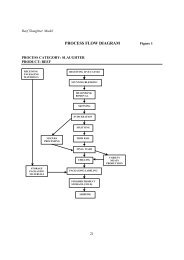Write down what went wrong and what you did about it in your diary.
Write down what went wrong and what you did about it in your diary.
Write down what went wrong and what you did about it in your diary.
You also want an ePaper? Increase the reach of your titles
YUMPU automatically turns print PDFs into web optimized ePapers that Google loves.
F<strong>it</strong>ness for workSafety po<strong>in</strong>tStaff should be ‘f<strong>it</strong> for work’ at all times. This means thatthey must not be suffer<strong>in</strong>g from, or carry<strong>in</strong>g, an illness ordisease that could cause a problem w<strong>it</strong>h food safety.Any member of staff who has diarrhoea <strong>and</strong>/or vom<strong>it</strong><strong>in</strong>gshould report <strong>it</strong> to their manager immediately <strong>and</strong> e<strong>it</strong>herstay at home or go home straight away. Staff should also telltheir manager if they have any cuts or sores.Why?People who are not ‘f<strong>it</strong> for work’ could spread harmfulbacteria to food.People suffer<strong>in</strong>g from these symptoms often carry harmfulbacteria on their h<strong>and</strong>s <strong>and</strong> can spread themto food or equipment they touch.Staff who have had diarrhoea <strong>and</strong>/or vom<strong>it</strong><strong>in</strong>g shouldnot return to work until they have had no symptomsfor 48 hours.Cuts <strong>and</strong> sores should be completely covered w<strong>it</strong>h abrightly coloured waterproof dress<strong>in</strong>g.Even if the diarrhoea <strong>and</strong> vom<strong>it</strong><strong>in</strong>g has stopped, someonecan still carry harmful bacteria for 48 hours afterwards.This is to prevent bacteria from the cut or sore spread<strong>in</strong>gto food.What to do if th<strong>in</strong>gs go <strong>wrong</strong>• If staff are not ‘f<strong>it</strong> for work’, move them out of foodh<strong>and</strong>l<strong>in</strong>g areas or send them home. Throw away anyunwrapped foods they have h<strong>and</strong>led.How to stop this happen<strong>in</strong>g aga<strong>in</strong>• Tra<strong>in</strong> staff aga<strong>in</strong> on this safe method.• Improve staff supervision.Diary<strong>Wr<strong>it</strong>e</strong> <strong>down</strong> <strong>what</strong> <strong>went</strong> <strong>wrong</strong> <strong>and</strong> <strong>what</strong> <strong>you</strong> <strong>did</strong> <strong>about</strong> <strong>it</strong> <strong>in</strong> <strong>you</strong>r <strong>diary</strong>.DiaryManage <strong>it</strong>Make sure that all staffunderst<strong>and</strong> the importanceof be<strong>in</strong>g ‘f<strong>it</strong> for work’.It is a good idea to have aseparate area where staff canchange <strong>and</strong> store their outdoorclothes.Why?This is so they underst<strong>and</strong> how some types ofillness can affect the safety of food <strong>and</strong> thatthey must tell their manager if theyhave these types of illness.Clothes could be a source of bacteriaif they are left ly<strong>in</strong>g around.How do <strong>you</strong> do this?Make a note <strong>in</strong> <strong>you</strong>r <strong>diary</strong> ofwhen <strong>you</strong> have tra<strong>in</strong>ed staffon this safe method.Where do staff change <strong>and</strong> storetheir outdoor clothes?It is good practice to keep aclean set of work clothes ordisposable aprons for vis<strong>it</strong>ors.Anyone enter<strong>in</strong>g the k<strong>it</strong>chen can br<strong>in</strong>g<strong>in</strong> bacteria on their clothes.Where do <strong>you</strong> keep cleanuniforms/disposable aprons?CC2/09-06











